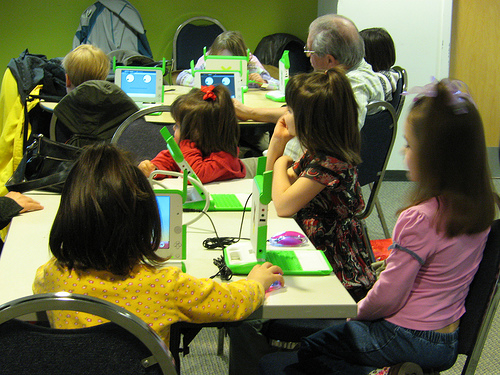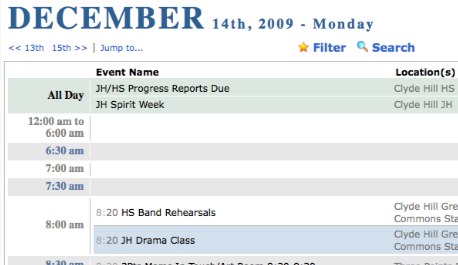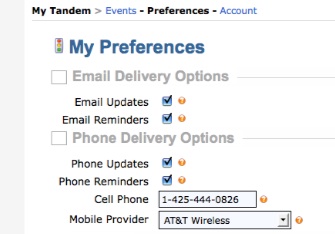Questions Every School Administrator Should Ask Before Investing in a Technology Solution
“Integrating technology throughout a school system is, in itself, significant systemic reform. We have a wealth of evidence attesting to the importance of leadership in implementing and sustaining systemic reform in schools. It is critical, therefore, that we attend seriously to leadership for technology in schools.” – Don Knezek, Director of the Technology Standards for School Administrators (TSSA) Collaborative
While technology can often be a positive so urce for increased efficiency and productivity in schools, today’s administrators are faced with a barrage of options to choose from. Making the wrong choice when it comes to technology can not only be expensive but result in many hours of work invested for little gain – or worse.
urce for increased efficiency and productivity in schools, today’s administrators are faced with a barrage of options to choose from. Making the wrong choice when it comes to technology can not only be expensive but result in many hours of work invested for little gain – or worse.
Below is a list of fundamental questions each school administrator should consider before investing precious human and financial resources in implementing a technology solution:
What benefits – in time, money, efficiency — are we seeking to gain from implementing this solution?
All too often, organizations will invest in a solution because of a misplaced notion that “they have to” or “everyone else is.” If a solution ultimately doesn’t save you time, reduce expenses or increase efficiency – is it really worth it?
How much will it cost to implement? What is our return on investment?
In today’s economy, schools are more concerned than ever with managing their finances. When evaluating cost, school administrators should look not only at how much it costs to purchase a technology solution but the related implementation and on-going costs of training, support, upgrades, etc.
How well does this solution integrate with our current system and our school’s culture?
A school district invests hundreds of thousands of dollars in a state of the art PC-based computer lab only to find that a majority of students and faculty own Macs. Doing a thorough analysis and survey of what technology and systems are currently used can help schools avoid implementing solutions that ultimately end up collecting dust in a corner. After all, a solution is only as good as how well and how often it is used. In addition to evaluating the effectiveness and usage of technology systems, infrastructures and standards that are currently in place on campus, administrators should also consider what technologies and standards are being used by teachers, students, parents and other stakeholders outside of school.
Is this solution scalable and can it meet future needs?
Implementing a new technology solution takes time, money and resources – so it is important to make sure that you invest in a solution that not only meets current requirements but can easily be scaled or adapted to meet future needs. Costs for additional licensing, ease of customization, additional modules, etc. are all elements that should be considered when evaluating a solution’s scalability.
Photo by http://www.flickr.com/photos/curiouslee/ / CC BY 2.0
The following websites are both free and educational, spanning the academic spectrum across multiple disciplines and age groups. With a little guidance these sites should help students have a great time while exploring the wealth of knowledge around them.
Howstuffworks is a site is geared toward older kids or teens (or just curious adults), although it is also a great site to use as a resource. Great for those kids who have science based questions about consumer products, current events or just topics adults rarely stop to explain.
2. Factmonster
Factmonster is essentially a searchable encyclopedia for kids. Information can either be found by typing in the search bar or by following the link to various topics, like ‘money’, ‘people’ or ‘sports’.
3. Professor Garfield
At Professor Garfield students will learn about various academic topics with a focus on art and creativity. Students can make their own cartoons and watch videos of artists at work in a number of genres.
4. Funbrain
Funbrain has tutorials and games for such subjects as grammar, math and reading for all grade levels, including more advanced subjects like physics and chemistry. You can search games by grade level or age.
5. BBC Schools Typing
Typing is not a skill that we generally think to teach young children, but it certainly makes sense to start this indispensable skill early. At BBC Schools Typing, kids of all ages can learn to type with the fun tutorials.
6. Try Science
Try Science is an engaging website where kids can do virtual experiments or take virtual field trips related to science. Through the virtual adventures kids get to go through the stars or race across various terrain.
7. Internet4Classrooms
Internet4Classrooms is a comprehensive resource for all academic subjects and is easily navigated according to grade level and subject. Resources and links include both games and supplemental materials.
8. Kidsknowit
Kidsknowit is a network of free sites, each focused on a different academic area. Kidsgeo.com focuses on geology and geography, while Kidsbiology.com explores the human body and at Kidspast.com you can find games that help make history fun and memorable.
9) Kids National Geographic
Kids National Geographic is all the scope and depth of National Geographic brought down to kids size. The kid-friendly site includes dozens of games and activities based on geography, culture, science, adventure, nature and animals.
10. CoolMath4Kids and Cool Math
Coolmath4kids is full of fun puzzles and games designed to help elementary aged kids have fun with math. Coolmath focuses on pre-algebra and beyond and aims to get kids to have fun with math and overcome and negative feelings about difficult math topics.
This post was inspired by Mashable’s 10 Sites to Learn Something New in 10 Minutes a Day.
7 School Tools For Making Your School More Digital
Students growing up in the digital ag e are likely to engage with digital technology in more and more aspects of their life. Part of the role of schools is to prepare students for the rapidly changing world which is quickly becoming more digital every day as new tools emerge to replace things that traditionally didn’t require the use of computers. Here are 7 tools that schools can use to become more digital.
e are likely to engage with digital technology in more and more aspects of their life. Part of the role of schools is to prepare students for the rapidly changing world which is quickly becoming more digital every day as new tools emerge to replace things that traditionally didn’t require the use of computers. Here are 7 tools that schools can use to become more digital.
1. Microblogging
Twitter, has become a popular new communication tool that can be really useful if used the right way. Many teachers, school administrators, and others share valuable information on Twitter via 140 character “Tweets”. One of the most important aspects of Twitter is its integration with SMS, so that users of Twitter can receive messages from people they follow on their cell phones, which almost all teachers, students, and parents carry with them. A principal of a school can send out important messages which can be received by all followers. Twitter also makes it easy to send direct messages to individuals that will be sent to their cell phone as well as their Twitter account that can viewed in a browser.
2. Online school calendars
Calendars are a tool that been used for thousands of years and an online version of the calendar can make calendars more useful. Online school calendars can be accessed from any computer with an internet browser and can be updated in real time when changes occur. This is a major upgrade from a paper based calendar that is usually in one location and can only be updated when a new calendar is printed out and sent out. An online calendar can also provide much greater detailed information, help organize and manage all the schools events, send information to external personal calendars, and many more things that paper calendars can not do.
3. Social networks
Social networks allow for effective communication between groups of individuals online. Facebook for instance allows the creation of groups where individuals can post information, have group discussions, or interact with each other. Yes, there are opportunities for wasting time, but these are outweighed by the benefits of the facilitation of collaboration and communication. Schools can even create their own social networks using tools like Ning.
4. Blogging
Blogging has democratized the publishing of content so that now anyone can write and publish content that will be read by as many people who are interested. Many teachers write blogs to discuss issues in education, share useful educational resources, or engage with students and parents. Students can improve their writing skills by creating their own blogs about topics that they care about. Some free tools that help easily create and publish blogs are Blogger, Edublogs, and WordPress.com.
5. Digital books
There are many advantages of switching to a digital format for books. A digital text book or book is much lighter to carry, which reduces the heavy weight many students carry on their backs. They can be updated more frequently and less expensively when information changes. Digital content also tends to be less expensive, as it reduces the publishers costs to distribute. Many classic books are available for free in digital format. One school has even replaced their entire library with a set of Kindles.
Digital books can be read on laptops, the iPod touch, netbooks, or eReaders like the Kindle or Nook. With the Kindle, students can get access to almost any book in about a minute as well as preview a vast library. The Nook allows a sharing feature so books can be shared between devices for a limited time for certain titles.
6. Wikis
Most people know about Wikipedia, the community driven encyclopedia, but Wikis also have tremendous potential as a collaboration tool. Sites like WetPaint allow you to create a free wiki for your school, a school project, etc. Users can add, edit, or view content to these wikis which can be great for collaboration and sharing information.
7. Online Video/ Podcasts
Students have unprecedented opportunity to broadcast their ideas and creativity by creating videos or audio recordings and publishing them for free on sites like YouTube or Podbean for audio. Students can produce shows, movies, or speeches that can be distributed to a worldwide audience. Some students created a rap video about math that has received over 3 million views. Using Ustream, teachers could broadcast a live recording of a lecture. There are also tons of free online lectures from top universities covering various subjects that are available at Academic Earth, YouTube, and iTunesU.
Can you think of additional tools to add to this list?
Photo by http://www.flickr.com/photos/zappowbang/ / CC BY 2.0
Schools Save Money with Tandem
 Current economic conditions have many schools searching for ways to reduce costs without sacrificing a quality education.
Current economic conditions have many schools searching for ways to reduce costs without sacrificing a quality education.
Using Tandem for Schools, schools can not only improve communications with parents, staff and faculty but also more effectively manage school resources.
Facilities Management
Many school facility managers already use Tandem to avoid overbooking facilities or to resolve scheduling conflicts. Knowing when and how often a facility or room is used, Tandem can also help facilities managers better allocate budget dollars and achieve energy and other savings.
Identify New Revenue Opportunities
Many schools have venues which may be underused at different times of the year; by using Tandem, schools can identify these resources and potentially turn them into revenue generating sources by renting them out to outside groups, etc.
Transportation Management
How many buses? When? Where? Tandem allows for rapid fire communication to all stakeholders involved in an event. Tandem allows coaches, teachers and administrators to more effectively manage trips and reduce transportation costs. And advanced planning features allow school districts to budget transportation needs more effectively. Translation: more opportunities to save money.
School Administration
With multiple events at multiple venues going on at all times of the day, one last minute change can often lead to hours of work for staff and managing the calendar can be more than a full-time job. With Tandem, one change doesn’t have to lead to hours of phone calls and running around to parents, staff, etc. With Tandem, the minute the change happens, everyone can be updated instantaneously. One school district even was able to reduce the number of staff managing their calendar from two full time personnel to just one.
Lower Printing Costs
Rather than printing out school calendars and fliers reminding parents and students about upcoming school events, using an online school calendar can save time that is required to print out hundreds of documents and reduce the amount spent on paper and ink.
4 Reasons To Switch To An Internet School Calendar
There are many reasons why schools should make the switch to internet calendars from the traditional paper-based model. According to Tech Crunch “while more and more schools are turning to the web as a platform, less than 5% of schools, both public and private, are offering parents internet school calendars.”
1. Help communicate more effectively through digital tools
As more mobile devices gain internet connectivity, the internet is becoming more ubiquitous in our normal everyday activities. School communication can be amplified through digital tools like an internet school calendar that can be accessed from virtually anywhere that the internet is available. This allows students and parents to bring their school calendars everywhere they go and receive valuable school information in real time.
2. Reduce carbon footprint/save paper
One of the main sources of waste in schools was traditionally the printing of information. The distribution of important school information often required the printing of massive amounts of documents -monthly calendars, fliers, etc.. An internet school calender can eliminate the need to print documents and save a significant amount of paper and ink, which not only reduces the carbon footprint but costs as well (ink can cost thousands of dollars per gallon).
3. Encourage greater involvement of students and parents
There is little doubt that schools that are able to better engage their students, parents, and communities, will have better educational outcomes. Students who are engaged with after school activities improve their chances of getting into the college of their choice, and parents who are involved in school activities help student success. An internet school calendar can encourage engagement by providing information on school activities to make it easier to participate.
4. Reduce workload of school staff
Administrators who have switched to an internet school calendar often report a significant reduction of parent phone calls to the office. When school scheduling and event information is published to a central and updated location, like an internet school calendar, parents do not need to call the office for information.
Managing events for an entire school of up to thousands of students can be a monumental task. School event scheduling software like Tandem for Schools can make this task much easier with a streamlined facilities request system, automatic conflict checking, and simple publishing of events.
Learn more about switching to an internet school calendar. Schedule a free online demonstration of Tandem for Schools on your own computer.
If you are a parent and would like to support internet school calendars, you can suggest that your school consider switching at SchoolCal.org.
 1. Receive text message updates of specific school events
1. Receive text message updates of specific school events
Users of Tandem for Schools can get updates on school events sent directly to their mobile device via SMS. You can set up reminders for a specific event or updates on a school group like “Varsity Girls Soccer”.
2. Users can request to reserve a facility
Users that have been granted permission can send a request to the calendar manager to request to book an event at a specific time and place.
Members of the community could even be invited to request facilities for community events when the facilities are not in use, and the school can earn extra money.
3. Double booking conflict checking
When events are requested by users, Tandem for Schools automatically alerts the calendar manager whenever there is a scheduling conflict. This simplifies event scheduling for the school administrators and prevents two school groups from accidentally scheduling events at the same venue at the same time.
4. Post pictures and news of events
Anyone can upload photos and text into an event, which can be approved by the calendar manager. This can include action shots of a sports event or statistics from a game. Anyone can also submit reminders before the event like “Admission for non-students is $3”.
5. Manage school bus transportation to events
Tandem for Schools can be used to manage logistics for transportation to school events. Administrators can schedule bus trips, manage trip budgets, and manage requests from coaches.
6. Sync calendar with personal online calendars
Parents, students, and faculty may already have a personal online calendar that they use to manage their schedules such as Outlook, Google Calendar, iCal, or Cozi. No problem! Users of Tandem for Schools can sync the events that are important to them so that they are automatically fed to your existing online calendar.
7. Access the calendar from anywhere you have internet access
With Tandem for Schools, you don’t have to be at your desktop to access the school online calendar. The calendar is available online at a specific URL assigned to a school or district.
8. Filter events/Create custom calendar
You can filter the main school calendar to only show events that you specify. You can also set up a custom calendar that will only show events related to groups that you have chosen to track.
9. Customize calendar with school colors and logos
You can customize the look of your online school calendar to reflect your school colors and school logo.
10. Multiple views of the calendar
You can change the view of the calendar to yearly, monthly, daily, or list of events.
To learn more about the useful features of Tandem for Schools see the following blog post:
8 Things Parents Can Do With Intand’s Online School Calendar
or schedule a free demo on your own computer via Go To Meeting.
Google Wave is a new service fr om the internet giant that has the potential to greatly enhance the way students communicate with each other when creating group projects for class. Wave combines many of the best features and benefits of other real time editing tools into a near total solution for group work and project development.
om the internet giant that has the potential to greatly enhance the way students communicate with each other when creating group projects for class. Wave combines many of the best features and benefits of other real time editing tools into a near total solution for group work and project development.
When Google Wave is launched a student or educator will immediately be presented with a window where waves are separated into viewing fields in the center and right hand side of the screen. A handy organizer (much like an e-mail folder lit) and contact’s list are present on the left side.
A button aptly labeled “New Wave” will start a new project, and this is where a teacher or student can really begin to utilize the features of this service. If a social studies class project requires four partners to work together to create a presentation, then each of the four students can be quickly added to a new Wave specific to their assignment.
Each participant can log in and out of the Google service from home, school, or a public library while conducting independent research. Videos, pictures, and other attachments can be uploaded directly into the Wave viewing field for quick and easy access to all source materials; this also provides an easy way to back-up all versions of a project!
Wave provides many handy features and keyboard shortcuts that make it an ideal choice for schools where students are encouraged to utilize laptops for note taking and homework assignments. Students can add materials, chat about the progress of a class project, and more after mastering a few quick commands provided in an introductory video to Wave compiled by Google (this video will show up in a sample wave the first time the service is accessed).
Teachers concerned about unevenly balanced workloads within a group project can easily view a Wave with the built-in playback feature and see the development of the Wave (and research) to ensure that all students are properly credited for work done. Teachers can also use this feature to ensure that all participants are behaving according to school rules when communicating with each other in the course of a classroom assignment and to make sure that no instances of cyber-bullying occur. Parents and teachers can also rest assured their students are safe, as Waves can only be viewed by contacts who have been cleared to contribute to the project.
Google Wave provides a tremendous amount of benefits to the teacher or student wishing to maintain a hub for real time project collaboration in a controlled environment. Classroom and school utilization of Google Wave will help students learn the collaborative skills needed to succeed in a business world that centers around social media integration and introduce them to practical applications of technology.
Google Wave demo video:
Tandem for Schools, our online school calen dar software now offers text message integration so that users can receive text message updates of the school events that they care about.
dar software now offers text message integration so that users can receive text message updates of the school events that they care about.
Parents, students, and faculty can be away from the computer for most of the day, but many people carry around a cell phone with them at all times. If they have a user account with their school’s Tandem calendar they can change their preferences so that selected updates get sent directly to their phone via text message.
Currently users can log in and set reminders for specific events so that an email will be sent to their email inbox to remind them of an event within a specified time before the start of the event. You can also get email updates sent for all changes or new events for a specific group like Girls Varsity Soccer or Drama Club.
Text integration of a school calendar can improve school communication and save time for parents students and faculty. For instance, say you are a busy parent driving to a school baseball game, which has been canceled due to rain. You may receive a text message on your phone alerting you of this if you have signed up to track events for Boy’s Baseball and have them sent to your phone. Say you are a principal of the school and you want to alert students, parents, and faculty that school will be delayed for 2 hours due to an unexpected snow storm. You can add an event to the school calendar under a group called “Important School Notifications”. Now everyone who has signed up to track this group and receive text updates in their Tandem account can be notified of this important information via a text message.
Interested to learn more about Tandem school calendar software? Set up a free 1 on 1 demonstration on your computer here.
